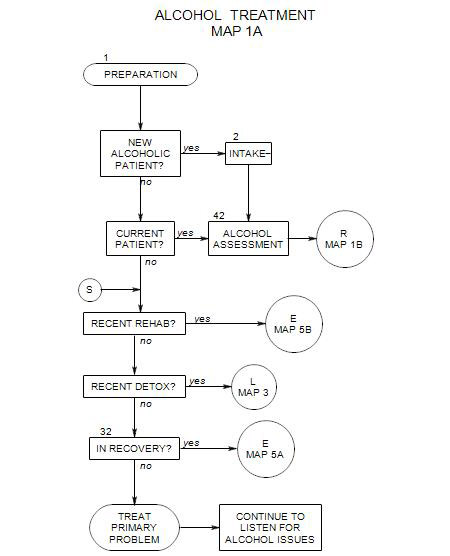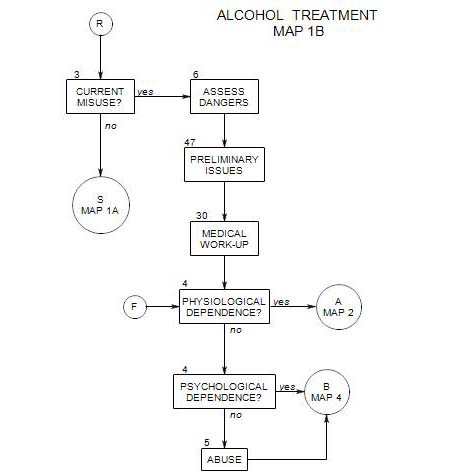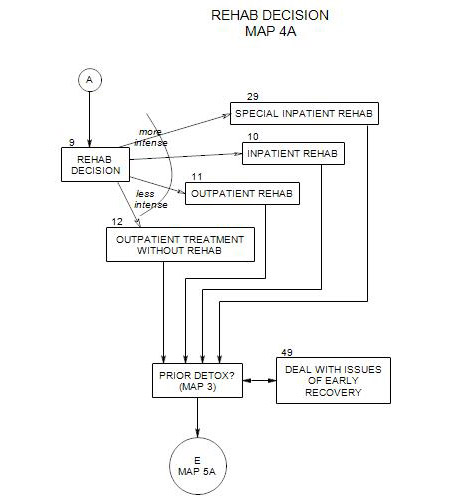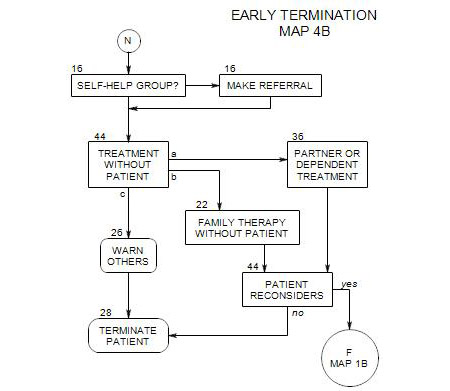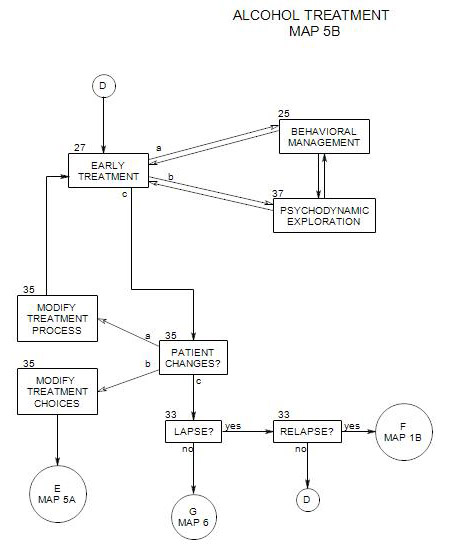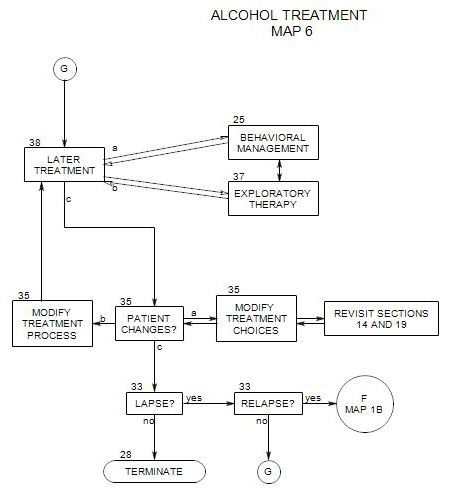24. MOTIVATIONAL INTERVIEWING
- This section doesn’t appear on the maps. It is referred-to by Section 2 and Section 27
24a. Overview
Motivational Interviewing (MI) is not so much a codified program as a perspective on treatment. What follows is one way of looking at this perspective. The definitive book is Miller and Rollnick (2002).
MI has been shown to be especially helpful when dealing with an alcoholic patient early in the treatment process. The therapist’s goal is to get the patient to the point of taking action to deal with his/her drinking. The patient typically has mixed feelings about the move, or appears openly resistant to the changes involved. The problem is to deal effectively with patient resistance and get the patient to cooperate for his/her own benefit. During the early stages of change, MI may be the most effective approach to take. Once the person has reached the action stage, other treatment techniques are available, and MI can be used in concert with them.
Motivational interviewing is not designed in itself to change a person’s life, but rather to help the person recognize the need for change. For some people, awareness may be enough: they will take action on their own without additional treatment. For others, increased motivation to change is a prerequisite for using other forms of therapy.
According to Miller and Rose, there are two major effective components to MI. The relational component involves accurate empathy and an “interpersonal spirit”, that emphasizes collaboration between therapist and patient, evoking client motivation and honoring the client’s autonomy. In this way, MI closely follows the psychotherapeutic approach of Carl Rogers. The technical component involves evoking and strengthening the client’s “change talk” by responding differently to different kinds of verbal productions. In this sense, it differs from Rogers’ nondirective approach in that the therapist has specific goals and directions in mind and is actively working toward them.
24b. The Relational Aspect of MI
A basic assumption here is that change cannot be effectively imposed from without and must come from within the patient. If you convey acceptance of the person as he/she is, he/she is freed to change. However, if you are more directive, controlling and punitive, a patient is more likely to resist your efforts and fail to change.
For a patient to change, he/she must focus on his/her own issues, which is so difficult to do that alcoholics commonly fail on their own. Alcoholics use a variety of defenses to avoid facing difficult issues directly, including drinking. The psychotherapy setting offers a safe place where the patient’s issues can be addressed, including the patient’s drinking behavior.
The spirit of MI includes [a] a collaborative rather than authoritarian approach [b] evoking client motivation rather than trying to install it and [c] honoring client autonomy, rather than being directive or trying to control the patient. This is of course consistent with many other forms of psychotherapy., However, MI is unusual in that its proponents have demonstrated its greater effectiveness in comparisons with more controlling and punitive treatments.
Descriptions of motivational interviewing commonly list the following as therapeutic strategies. A therapist is asked to
- Be empathic
- Help articulate patient goals
- Explore any patient ambivalence
- Roll with the patient’s resistance
- Support patient self-efficacy and responsibility
- Offer feedback, advice and choices when the patient needs them
BE EMPATHIC
Empathic understanding is a fundamental component of every form of intervention, including motivational interviewing. Accurate empathy, attentiveness, congruence and positive regard help to create an atmosphere of safety in which patients are freed to explore and change.
To be empathic is to try to see the other person’s private world as if it were your own, and to communicate your understanding of that world to the patient. This may at times include meanings that are outside the person’s immediate awareness. In the present context, our primary concern is with the patient’s drinking behavior; but the same is true of any other issues that the patient may need to work on.
Empathy must be expressed in order to be helpful to patients. You show your empathy in many ways, including
- the use of open-ended questions that encourage a person to talk freely. Asking for more information or more detail.
- reflective listening. Reflection consists essentially of repeating back what the patient has just said. Among other things, this shows that the therapist is paying attention, and provides support and encouragement for the patient to continue.
- respecting the patient’s choice of issues to address. Once you both are working together, there will be opportunities to help the person work on the drinking problem.
- affirmation of the patient and selective agreement with his/her thoughts, feelings, or observations,
- giving voice to the patient’s resistance, to elicit his/her own arguments for change
- summarizing. If the patient has stated an ambivalent position, then include both sides in the summary
HELP ARTICULATE PATIENT GOALS
Most people have at least some vague notion of the good life, and of their own personal hopes, aspirations and dreams for the future. Helping a patient articulate long-term dreams and goals in life helps give direction to his/her current actions. This can also include specific plans and wishes about work, family, or other relationships
Drinking can then be raised in the context of the person’s goals. Whatever a person’s reasons for drinking, it is at least partly undermining the person’s ability to reach some of them. When goals have been clearly expressed and articulated, the impact of a person’s drinking will be more obvious. Here is where discrepancies are to be found. By clarifying goals, the patient will have a clearer choice between his/her own wishes and dreams and his/her own behavior. There is less need for a therapist to press for abstinence when the person clearly sees the advantages of it. The problem is internal to the patient.
EXPLORE THE PATIENT’S AMBIVALENCES
From the perspective of MI, people are not unmotivated about drinking – they are ambivalent. Even though they may realize that their drinking is bad for their long-term health and goals, they consistently choose the immediate relief or reward that alcohol offers. The therapist’s job is to assist the patient in moving him/herself toward favoring his/her long-range best interests.
However, if you press ambivalent people to take one or the other of two inconsistent courses of action, they often defend the other course. So if you press ambivalent people to stop drinking, they are more likely to want to continue. But then, by defending drinking and continuing to drink, patients appear to be resistant to treatment. From this point of view, defensiveness is better seen as reaction to pressure than as a character trait of alcoholics. Instead of pressing an alcoholic for sobriety, it is generally more effective to join the patient’s ambivalence by exploring and articulating both sides.
You can focus on patient ambivalence in various ways:
- Get the patient to explore both sides: the advantages and disadvantages of continued drinking. Ask first what the benefits are, then what the problems are. Help the patient look at both sides of the issue at the same time.
- Similarly, the advantages and disadvantages of drinking relative to the patient’s long-term interests and goals can be explored, once they have been articulated.
- Help the patient recognize that the conflict is between his/her own behavior and his/her own goals.
- Articulating ambivalence leads to discomfort, which is motivating. However, it is – and should remain – internal discomfort rather than conflict between patient and therapist. The patient is naturally motivated to resolve any such inconsistency, and the therapist can serve either as an observer or a facilitator as needed.
- Once the patient starts to articulate ambivalences, the therapist must appear to remain neutral. The patient may attempt to draw the therapist in to one side of the ambivalence, to develop an argument with the therapist and avoid the discomfort of internal conflict.
ROLL WITH RESISTANCE
Resistance is defensive behavior in the treatment setting. People who are more resistant are less likely to change; early in therapy, they are more likely to drop out.
There is a common tendency to blame treatment failure on patient resistance and attribute the resistance to patient pathology. However, to do so ignores other aspects of the treatment: the therapist, the immediate therapy setting and the larger context of treatment. While the patient may be the one expressing resistance, any of the other aspects of treatment could be contributing to it.
If resistance is understood as a form of communication from patient to therapist, then the problem becomes to one of understanding what the patient is saying and why. If you can reformulate patient resistance as a consequence of a larger range of factors, you may be able to address the underlying issues and make change easier for the patient.
The MI literature recommends an examination of therapy style at such a time. It may be that the therapist has not been sufficiently empathic, possibly by being confrontational or getting drawn in to an argument with the patient. To roll with resistance is to use it as a signal that therapy needs to be modified, which may involve
- A re-exploration of the patient’s position, so the therapist can be more empathic
- Greater use of reflective statements
- Greater appreciation of the patient’s intrapsychic conflicts
- Focus on both sides of the patient’s ambivalences
- Less effort toward trying to convince the patient of something
- Greater appreciation of the patient’s perceived need to drink
- Re-negotiation of the therapy contract, especially for mandated patients who may be afraid to disclose information that the therapist thinks is necessary
SUPPORT SELF-EFFICACY
Self-efficacy is the patient’s belief that change is possible and that he/she can make it happen. The lower a person’s temptation to drink and the higher his/her confidence in being able to abstain, the higher his/her self-efficacy relative to drinking. Typically, as patients move from precontemplation to action, their self-efficacy increases.
There are many ways to support the patient’s self-efficacy, including
- offering the patient options for achieving his/her goals and letting the patient choose .
- recognizing that the final responsibility for success or failure is the patient’s
- helping to identify coping strategies that the patient already has
- exploring the patient’s personal strengths and reviewing past successes
- elaborating on statements about feeling confident
- believing in the patient’s ability to change
- offering help when the patient wants it
- providing reassurance
- encouraging “change talk”
24c. Technical Components
MI isn’t non-directive. The therapist has a general plan, at least relative to the patient’s drinking, and interventions are chosen that help the patient realize his/her own [1] ambivalence; [2] goals; [3] inconsistencies or discrepancies; [4] opportunities for change.
Technical components include focused exploration, reframing, modified or amplified reflections and summaries. Each of these involves showing awareness of and sympathy for the patient’s point of view, while at the same time re-presenting it from a slightly different perspective.
FOCUSED EXPLORATION
Once the patient feels the therapist’s concern and empathic awareness, he/she can be directed to talk about goals and specific situations in greater depth than usual. Drinking can be a way to not-think. Therapy allows the patient to think in a safe environment with support and encouragement, about things that have been avoided.
By selecting issues to focus on and the details to pay attention to, the therapist guides the exploration into areas that the patient may have previously been unaware of or actively avoiding. Therapist involvement makes these areas safer to explore.
MODIFIED OR AMPLIFIED REFLECTIONS AND SUMMARIES
Reflection doesn’t have to be an accurate replication of the patient’s statements. The reflected content can be modified in many ways, as a way of changing the direction of the session and the patient’s focus. You can add new meanings, alter meanings slightly and gauge patient reaction. You can exaggerate the patient’s statements as a way of exploring the limits of his/her thinking, and watch for a reaction. These and similar techniques can be used to move a patient toward greater awareness of discrepancies, better definition of goals, greater sense of the patient’s own power, and so on.
Reframing and summarizing have similar possibilities as techniques for modifying the patient’s thinking in the session. The purpose is to help the patient break out of a perspective that is harmful and see him/herself from a different point of view.
HELP THE PATIENT SEE DISCREPANCIES
Discrepancies are inconsistencies: differences between the patient’s behavior and his/her goals; ways that the patient undermines him/herself. Especially important are discrepancies between the patient’s life goals or values and drinking or other self-defeating behavior.
They may become evident in therapy, as the patient focuses on issues that have been previously avoided. The important point is for the patient to recognize the discrepancies.
Discrepancies are discomfiting. That discomfort motivates the person to want to change. The confrontation occurs within the patient because of the destructive nature of the patient’s addiction, and not between patient and therapist. The therapist can remain supportive and empathic while encouraging the patient to recognize and react to the issue.
ENCOURAGE “CHANGE TALK”
Change talk consists of any patient verbalizations that are indicative of the patient’s motivation to change. It includes any speech that favors sobriety: expressions of desire to change, indications of the patient’s ability to change, reasons for change and the need to change. By contrast, resistance consists of verbalizations that favor the status quo; “sustain talk”, or talk about continuing use of alcohol, reasons to continue drinking, the pleasures of drinking, or the need to drink.
The kind of talk matters. The strength of the patient’ expressions of desire, ability, reasons and need for change are better indicators of motivation than the frequency with he/she considers the issue. Stronger commitment language is generally a sign of greater readiness to make a change.
Miller and Rollnick [2002] discussed two sequential levels treatment in this area:. [1] elicit change talk to stimulate intrinsic motivation for change [2] when “sufficient motivation appears to be present, strengthen commitment by focusing on specific change goals and plans.
24d. Application of MI Within the Stages of Change
Early on, the main issue is to engage the patient in the treatment process. At this time, the relational aspects of MI help the patient see the therapist as an interested and involved party to his/her work, and the technical aspects help move him/her toward taking action.
Along with early engagement, you need to assess the patient’s level of change, so that any interventions match the patient’s awareness of his/her issues.
Treatment is more likely to be effective if it is consistent with the patient’s stage of change [ Section 40 ]. Both behavioral management [ Section 25 ] and psychodynamic therapy [ Section 37 ] are most effective with patients who are at the action stage: ready to do something about their alcohol misuse. The issue for them is how to go about making the changes that they are already at least somewhat committed to.
Precontemplators
People in this stage are either unaware of problem behavior or are unwilling or discouraged when it comes to changing it. The therapist’s task is to diffuse the patient’s resistance to change in a positive way. Empathy, interest, and a focus on the patient’s personal goals are helpful in engaging the patient. At the same time, you can be watching for ways in which the patient undermines him/herself and looking for points of ambivalence about drinking. Try to identify the patient’s kind of resistance to change, as a basis for moving forward.
Diclemente and Velasquez (2002) describe four kinds of resistance in precontemplators: reluctance, rebellion, resignation, rationalization. A particular patient may be a combination of these
Reluctant precontemplators are not actively resistant; they are stuck and don’t want to consider changing. They may be afraid of change or think it will be too difficult. Treatment involves sensitive listening and allowing them the time to make up their own minds.
A rebellious precontemplator may be aware of the consequences of drinking but either be emotionally invested in it or determined to make up his/her own mind about continuing. He/she may be mandated and not want to be there, or attacked and judged for drinking. He/she may try to argue with the therapist, and give many reasons for not changing. There is a danger of getting drawn into a nonproductive argument that could allow the patient to justify leaving.
Treatment includes agreeing with the patient that no one can force him/her to change. Allow the expression of strong feelings and support the patient’s freedom to choose. Follow the patient into whatever he/she sees as the problem, and re-introduce drinking when it is clearly interfering with the patient’s identified problem
Resigned precontemplators may have attempted to stop drinking or may only have thought about it; but in any case, they have given up on getting sober and seem overwhelmed by the problem. Treatment includes instilling hope and exploring barriers to change. Patients can be encouraged to see that behavior change is difficult but not impossible, and that relapse is common and not a sign of failure.
Rationalizing precontemplators seem to have all the answers; but their resistance is in their thinking, not their emotions. They think that change doesn’t pay, or blame someone else for their problem. Treatment includes empathy and reflective listening, double sided reflections, and summarizing both sides.
Contemplators
A person in the contemplation stage may recognize that he/she has a problem and start to think about dealing with it. However, he/she is not yet prepared to take action to resolve it. A therapist needs to recognize that ambivalence is part contemplation stage, and that the patient isn’t committed to change just yet.
Treatment Strategies include defining the two sides of the dilemma, exploring both sides thoroughly, and reflecting both sides to the patient. On one side are the benefits of continuing to drink, which must be substantial or the patient would already have stopped. Therapist appreciation of this side helps open the patient to realistic consideration of the conflict. The other side includes a focus on the risks of continued drinking, the benefits of change, and hope that change is possible. The therapist can help the patient get accurate feedback on the impact of drinking on his/her life.
Preparation
A person in the preparation stage has made a decision to change but has not yet become engaged in effective action to implement it. Here the person may still be ambivalent about what to do, how much needs to be done, how long he/she must be engaged in the change process, and so on.
Treatment involves helping the person develop an effective change plan that he/she will be able to follow. This may include providing a menu of treatment options, and helping the patient evaluate the advantages and disadvantages of each option.
Action
In this stage, which continues until the patient’s sobriety is consolidated, people make the move to implement their action plans. This is a point where other therapies become important. MI moves from being a primary treatment approach to adjunctive status within the therapy setting. The MI component includes exploring any remaining ambivalences and supporting patient self efficacy by focusing on successful activity and reaffirming decisions he/she has made.
Maintenance
A major problem here is loss of motivation leading to relapse. This can easily happen, as the person tries to remain constant in the face of changing life events and pressures. At this stage, the recommendations of MI are consistent with the recommendations of other approaches. They will be considered in Section 33.
References
Excellent brief treatments of Motivational Interviewing include [1] Rollnick and Allison “Motivational interviewing”, ch 7 in Heather and Stockwell (2007), and Miller in Hester and Miller (2003). The definitive booklength treatment is Miller and Rollnick (2002)
